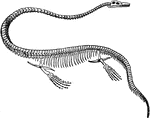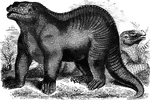Clipart tagged: ‘dinosaur’

Archegosaurus Head
Archegosaurus is a genus of amphibian which lived during the Asselian to Wuchiapingian ages of the Permian,…

Dorsal Vertebrae of the Archegosaurus
Archegosaurus is a genus of amphibian which lived during the Asselian to Wuchiapingian ages of the Permian,…

Dorsal Vertebra of Branchiosaurus
Branchiosaurus (Greek for "gill lizard") is a genus of small, lightly-built early prehistoric amphibians.…
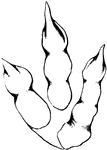
Brontozoum Giganteum
This illustration shows the track of a Brontozoum Giganteum. The trac is actually eighteen inches long,…
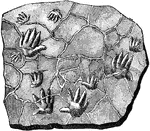
Chirotherium Tracks
Tracks of Chirotherium or "hand-beast" in Buntsandstein found in Hessbeg, Germany.
Diplodocus
An illustration of a Diplodocus skeleton and the caudal vertebrae (A and B). Diplodocus is a genus of…
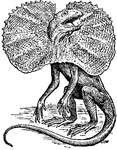
Frilled Lizard
Found in Oueensland and other parts of Australia, this lizard belongs to the family Agamidae. It reaches…

Glyptodon
"Glyptodon (Glyptodon clavipes). The typical and best-known genus of the family Glyptodontidae; the…

Hylaeosaurus
The hylaeosaurus measured between twenty and thirty feet in length, and fed on vegetation.

Dorsal Vertebra of the Hylonomus
Hylonomus was an early reptile. It lived 315 Ma (million years ago) during the Carboniferous period.…

Vertebral Column of Hymenochirus
African dwarf frogs of genus Hymenochirus, also known as dwarf aquatic frogs, are frogs native to Sub…
Archaeopteryx Skeleton
An illustration of an Ichthyosaurus skeleton. Ichthyosaurus is an extinct genus of ichthyosaur from…

Ichthyosaurus Skull
An illustration of an Ichthyosaurus skull. Ichthyosaurus is an extinct genus of ichthyosaur from the…
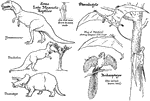
Late Mesozoic Age Reptiles
Some Late Mesozoic reptiles. Shown are the Tyrannosaurus, Trachodon, Triceratops, Pterodactyls, and…
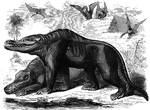
Megalosaurus and pterodactyls
A pair of megalosauruses, with a group of pterodactyls in the background.

Megatherium Skeleton
Megatherium ("Great Beast") was a genus of elephant-sized ground sloths that lived from two million…
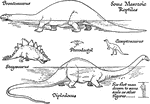
Mesozoic Age Reptiles
Some Mesozoic reptiles. Shown are the Brontosaurus, Stegosaurus, Pterodactyl, Camptosaurus, and the…

Pterodactyl
A remarkable genus of fossil lizards, peculiar to the Mesozoic strata. Its anomalous structure was long…

Pterodactyl
A remarkable genus of fossil lizards, peculiar to the Mesozoic strata. Its anomalous structure was long…

Pterodactyl
"A genus of extinct flying reptiles of the order Pterosauria, found in the Jura Limestone formation,…

Pterodactyle skeleton
"So peculiar and strange is the structure of these animals, that the first specimen discovered was classed…

Megalosaurus Skull
An illustration of the skull of a megalosaurus. Megalosaurus is a genus of large meat-eating theropod…
